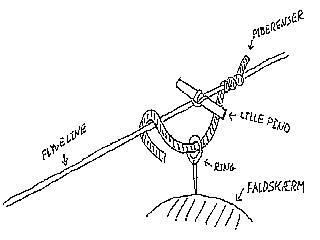A Spinning 'Chute
|
WARNING: The drawing is quite large (app. (ca. 634x940 pixels), so your browser may not be able to show it.
I nothing appears, try letting the browser load, save via the "File" menu and
view the picture with another viewer. You can also get both the drawing and this instruction in one move by downloading this
file:
[spinchut.zip] (38.9K)
During the last couple of years we, in Randers Kiteclub, have trained all kinds of teddy bears to be para-fauna: Death defying parachute-jumping daredevils.
One thing our teddys have learned the hard way is that the shroud lines on the normal hemispherical parachute tend to tangle or get twisted thus preventing the 'chute from deploying completely. Our two instructor-teddys, Pascal and B.O.B. (Bail Out B.O.B.), therefore suggested this spinning parachute, the spin-chute. It is easy to make and as good as always deploys perfectly.
The spin-chute was primary developed for public para-dropping, where you have a bunch of waiting children with various stuffed fauna, and you don't want to spend a lot of time untangling shroud lines, or packing 'chutes in release-packs. We haven't tried to use spin-chutes with release-packs, but it should work. Although 'chutes for use with release-packs are best made of unproofed ripstop nylon, I don't think it is wise to use unproofed ripstop for spin-chutes, as it stretchs too much along the venting holes.
This 'chute is sized for para-fauna weighing app. 100-150g.
All of the measurements on the drawing are in milimeters and includes seams. The top-panel has 5 mm added along all edges. The side-panel has a 5 mm seam along the CD-edge and 10 mm along FE. If the edges CF and DE on the side-panel are hot-cut they don't need to be hemmed.
The exact curvature of the curves TA and TB is not that important, as long as the two sides are alike. Make a curve with a 3 mm glassfiber rod for one side of a template and mirror it.
For the 'chute 6 top-panels and 6 side-panels are needed. As the Spin-Chute is spinning(!) it should be made from at least two (alternating) colours to make the rotation more visible.
First the 6 top-panels are sewn together: The curve TB on one panel is sewn to TA on the next. With all 6 panels sewn together you should have a slice of a sphere.
To each of the top-panels a side-panel is attached: The line AB on the top-panel is placed along the line CD on the side-panel. Remember to orientate all the pointy ends (E) on the side-panels the same way!
The side-panels are sewn together only at the bottom. The point E from one panel should cover the point F on the next panel by app. 10 mm. The use of a glue-stick or hottacking makes the sewing easier. Finally a double-hem is applied to the rim of the spinchute.
For attaching to the dropping device a 2-3 cm long loop of line is sewn to the top of the spinchute.
The line is cut into 6 pieces each measuring 160 cm. Each line is folded in half and a loop is made on the middle. A line goes in each E/F-point and in the points halfway between them. Using a large needle, thread the 12 line-ends through the rim of the 'chute and tie them.
The 6 loops are gathered in the keyring which is attached to the swivel. A elastic loop of proper size is tied to the swivel.
Now all you need to do is to convince your teddy of the sanity in beeing hauled aloft to breathtaking altitudes (remember the drifting!) with nothing between himself and an ill fate but your newly finished... spin-chute!
When the dropping is to take place, one of the easiest ways is suggested
in "Kites" by Ron Moulton. All that is needed is a pipecleaner and a little rod,
which together with the 'chute is attached to the kiteline close to the kite: (The words
on the drawing are danish, just ignore them.)  The idea is to let all the needed kiteline out before
letting the kite rise. When the kite gets all the way up there, the spinchute will
release. If not, a little tugging on the line will normally do the job.
The idea is to let all the needed kiteline out before
letting the kite rise. When the kite gets all the way up there, the spinchute will
release. If not, a little tugging on the line will normally do the job.
There is also a drawing for a Line-Ferry which can carry a bear up the line.
Esben Collstrup
ecoll@geocities.com